| UNESCO World Heritage Site | |
|---|---|
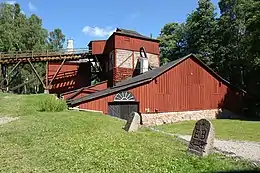 | |
| Location | Ängelsberg, Fagersta Municipality, Sweden |
| Criteria | Cultural: (iv) |
| Reference | 556rev |
| Inscription | 1993 (17th Session) |
| Area | 9.596 ha (23.71 acres) |
| Coordinates | 59°58′00″N 16°00′30″E / 59.96667°N 16.00833°E |
 Location of Engelsberg Ironworks in Sweden | |
Engelsberg Ironworks (Swedish: Engelsbergs bruk) is an ironworks in Ängelsberg, a village in Fagersta Municipality in Västmanland, Sweden. It was built in 1681 by Per Larsson Gyllenhöök (1645-1706) and developed into one of the world's most modern ironworks in the period 1700–1800. It is listed as a UNESCO World Heritage Site since 1993.
Name
Engelsberg Ironworks is named after Englika. Englika, who was born in Germany, began producing iron in Engelsberg in the 14th century.[1]
History
The history of iron production in the region dates back to at least 13th century. The local peasants both mined the ore and produced the iron using primitive furnaces.[2]
In the end of the 16th century more modern production methods were introduced in Engelsberg and production volumes increased substantially in the following decades.[2]
The mill, which historically belonged to the Västervåla parish and Norberg, was built in 1681[3] by the county sheriff Per Larsson Höök (1645–1706). By then, ironworking had already been carried out on the site for a long time by miners.[4]
Description
The preserved buildings include a manor house, the inspector's house and the smelting house with a blast furnace.[2]
UNESCO World Heritage Site
Engelsberg Ironworks is a UNESCO World Heritage Site. It was added to the list in 1993.[5] The UNESCO comments were:
Sweden's production of superior grades of iron made it a leader in this field in the 17th and 18th centuries. This site is the best-preserved and most complete example of this type of Swedish ironworks.
Gallery
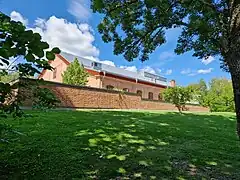 Conference center
Conference center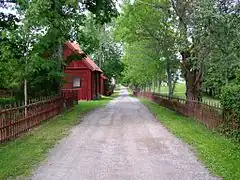 A road at Engelsberg iron works
A road at Engelsberg iron works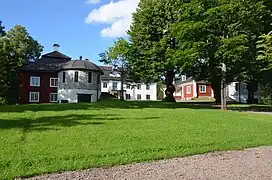 The mansion with wings
The mansion with wings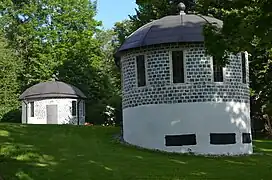 The two slag stone towers
The two slag stone towers The west wing
The west wing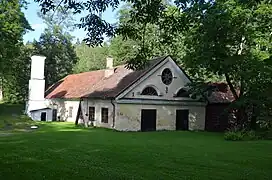 The forge
The forge The mansion from the garden side
The mansion from the garden side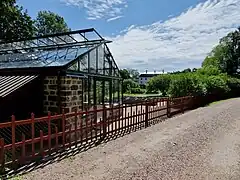 Kitchen and pleasure garden
Kitchen and pleasure garden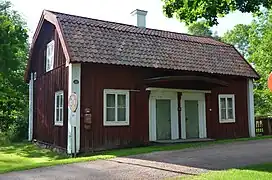 The old office
The old office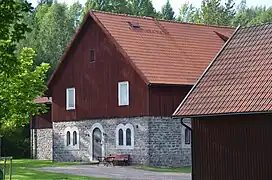 The archives of Axel Johnson Group
The archives of Axel Johnson Group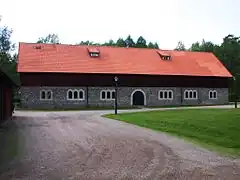 The old barn
The old barn The new office
The new office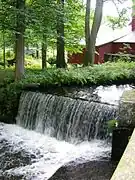 The dam and blast-furnace
The dam and blast-furnace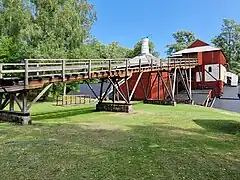 Rope railway for charcoal to the blast furnace
Rope railway for charcoal to the blast furnace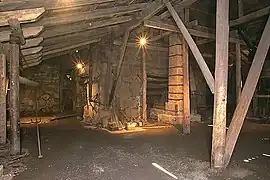 Casting house, blast furnace and air duct for preheated combustion air
Casting house, blast furnace and air duct for preheated combustion air
References
- ↑ "Världsarvet Engelsbergs bruk".
- 1 2 3 "Engelsberg Ironworks".
- ↑ "Ängelsberg - Uppslagsverk - NE.se". www.ne.se. Retrieved 2023-06-28.
- ↑ "Engelsbergs bruk - Värlsdarvet - Fagersta kommun - turistinformation". 2010-08-12. Archived from the original on 2010-08-12. Retrieved 2023-06-28.
- ↑ "Sweden".
External links